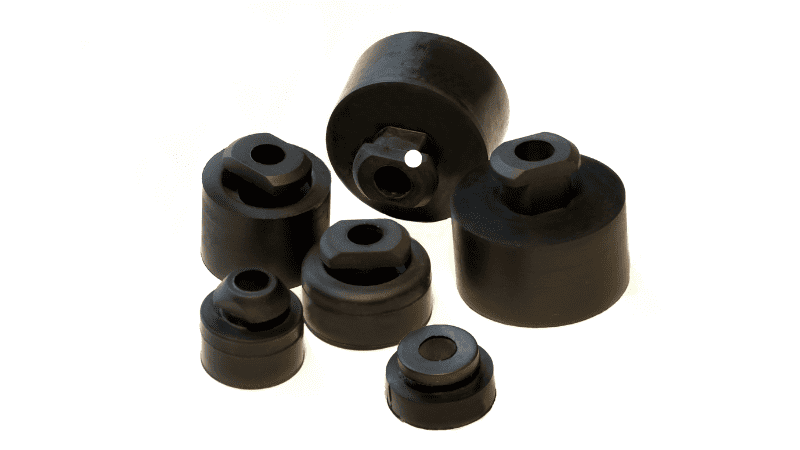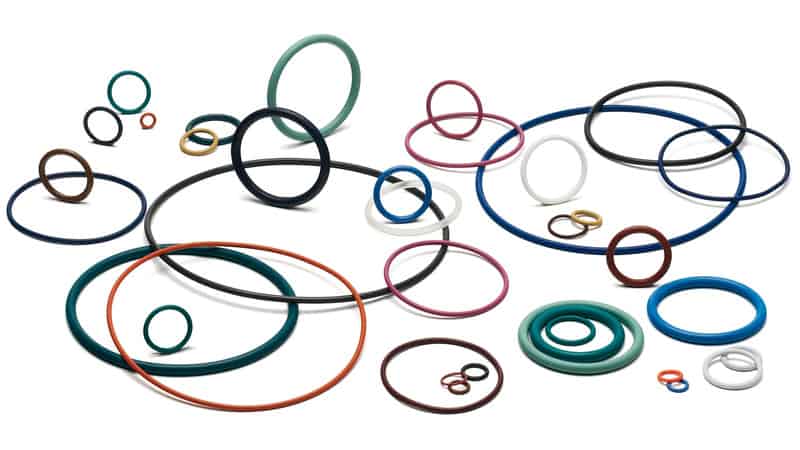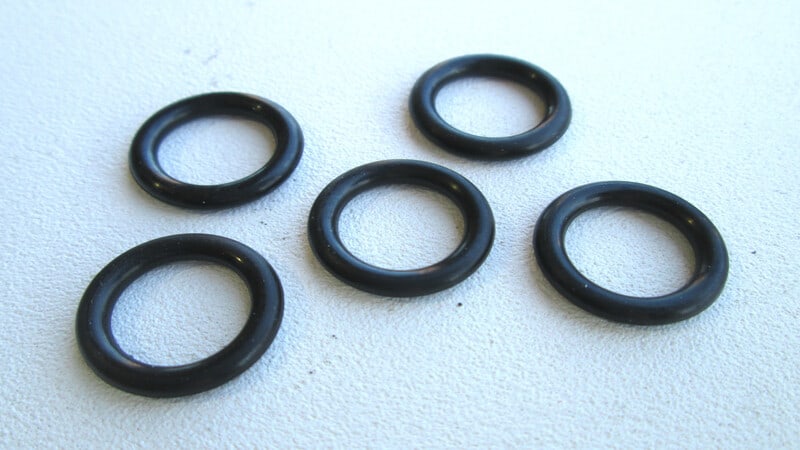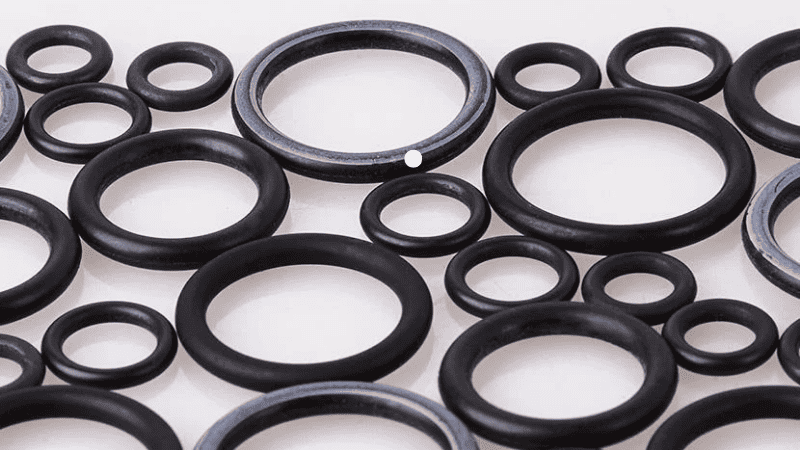What Is a Viton Material?
Viton is a proprietary elastomer designed on a fluorocarbon base by DuPont in the 1950s. It is a specialized synthetic rubber that is meant for high-temperature applications. Viton is a trademarked name, and the scientific name for this unique rubber is Vinylidienefluoridehexafluropropylene, shortened to FKM.
As the rubber is designed for high-temperature applications, Viton seals and o-rings are an excellent fit for car engines and other heavy machinery.

What Is a Buna Elastomer?
Buna is a butadiene-based synthetic rubber invented by a pair of German chemists in 1934. It is a low-cost rubber solution with exceptionally high tensile strength and decent chemical resistance. Buna rubber is commonly used in producing seals, o-rings, and surgical gloves.
Buna rubber comes in two variations based on its ingredients. Buna with an acrylonitrile group is called Buna-N or NBR (Acrylonitrile Butadiene), while one with a styrene group is called Buna-S or SBR (Styrene Butadiene).
The term Buna is generally used to refer to Buna-N, while SBR is used for Buna-S. It is also quite common to see Buna rubber marketed under the trademark name of Nitrile.
What Is the Difference between Viton and Buna O-rings?

Viton and Buna are two very different rubber compounds invented for different applications. For easier understanding, we can simplify the differences between the two rubbers. Buna is stronger and stretchier, while Viton is heat resistant. Following is a breakdown of other differences between the two materials. Let’s take a look together!
Mechanical & Physical Properties
A rubber’s mechanical and physical properties determine its strength, stretchiness, tear resistance, and resilience, the ability to bounce back to its original shape. Here is a list of common mechanical properties that affect the overall performance of both Buna and Viton o-rings.
| Mechanical & Physical Properties | Viton (FKM) | Buna (NBR) |
| Hardness | 50-95 Shore A | 20-95 Shore A |
| Tensile Strength | 500-2000 Psi | 200-3500 Psi |
| Elongation | 400-500% | 350-650% |
| Abrasion Resistance | Good | Great |
| Compression Set | Great | Great |
| Impact Resistance | Good | Fair |
| Resilience | Poor | Good |
| Tear Resistance | Good | Great |
| Vibration Dampening | Fair | Fair |
As we can see, Buna and Viton are similar in terms of physical properties. Both materials have excellent resistance of compression set and a good shore hardness range. However, Buna can withstand more tensile stress and has better abrasion and tear resistance.
Buna rubber is a generally good choice for most applications where material strength is the only consideration. You will find Buna o-rings inside kitchen appliances, smartphones, construction tools, and more. Buna rubber is also a lower-cost option, so choosing Viton for everyday applications makes little sense.

Thermal Properties
Rubber compounds often melt under high temperatures and become brittle in colder environments. These temperature restrictions limit the sealing applications of rubber o-rings significantly.
Regarding rubber temperature resistance, we separately measure the operating temperature for high and low temperatures. The following is a Viton temperature chart comparing it directly to the Buna-N temperature range.
| Temperature Properties | Viton (FKM) | Buna (NBR) |
| Cold Resistance | -30º to 0º F | -70º to 0º F |
| Heat Resistance | 450º to 500º F | 210º to 250º F |
The difference in temperature resistance is to be expected as Viton seals are specially designed for engine blocks. Viton has better heat resistance, while Buna has better cold resistance.
It should be noted that for colder locations like Iceland or Alaska, the low-temperature resistance of Buna will be more helpful. While the Viton seal temperature range is much more comprehensive, making it a better option for high-performance industrial applications. DuPont Viton is marketed explicitly toward high-performance combustion engines.
Environmental Resistance
Environmental resistance refers to material protection from natural elements like ozone, water, or UV exposure. Good environmental resistance is necessary for the longevity of an O-ring.
| Environmental Resistance | Viton (FKM) | Buna (NBR) |
| Colorability | Great | Excellent |
| Flame | Great | Poor |
| Gas Permeability | Great | Good |
| Ozone | Excellent | Fair |
| Sunlight | Great | Good |
| Water | Excellent | Great |
Here we see that the environmental resistance of Viton is miles ahead of Buna. Buna seals and o-rings can only withstand short-term exposure to water and sunlight. In contrast, Viton products can be deployed in outdoor applications without fear of environmental damage.
Another thing to consider here is that gas permeability is the ability of a gas to move through a material. So poorer permeability means the rubber o-ring will not let gasses pass through it.
Chemical Resistance
All synthetic and natural rubber compounds are very weak to chemical damage. Rubbers in high-performance applications often run into harsh chemical liquids and gasses.
These chemicals can quickly dissolve and corrode rubber seals and o-rings. So for deployment in large industrial spaces and hazardous environments, you need a rubber material with excellent resistance to all chemicals.
| Chemical Resistance | Viton (FKM) | Buna (NBR) |
| Acids | Great | Fair |
| Alkalies | Fair | Good |
| Amines | Poor | Poor |
| Vegetable Oils | Excellent | Great |
| Fuels | Excellent | Good |
| Ketones | Poor | Poor |
| Petroleum | Excellent | Good |
| Refrigerant | Great | Great |
| Silicone Oil | Excellent | Good |
| Solvents | Excellent | Great |
Buna rubber has better chemical resistance than most commonly used elastomers. But it fails compared to Viton with its excellent resistance to petroleum-based lubricants, mineral acids, silicone greases, and other solvents.
Send your inquiry for prompt quotations!
How Can You Tell If an O-ring Is Made from Viton or Buna?
All synthetic rubbers look very similar, and with the addition of colors, you cannot tell them apart quickly. However, you can use a few methods to tell if an o-ring is made from Viton or Buna rubber.

1. Un-colored Rubber Appearance
Pure, uncolored Viton o-rings have a greenish-brown hue. In comparison, uncolored Buna-N o-rings have a slight yellow hue.
Uncolored here means that no artificial coloring agents were used to change the color of the rubber. Unfortunately, most commercially available o-rings will be colored black for better aesthetics.
2. Elongation Capabilities
Buna-N can be stretched much further than Viton before breaking. A standard Buna-N o-ring will be almost twice as stretchy as a Viton one under standard operating conditions.
3. Reaction to High Heat
Another way to tell apart two o-rings is to place a small piece of them in a 300º-350ºF oven. If the rubber pieces melt within a minute, it is made of Buna. Otherwise, it’s Viton.
One important thing to consider here is that other synthetic rubbers like silicone and fluoro silicone can also withstand high temperatures. So you may have been sold a silicone o-ring instead of Viton.
4. Submersion in a Harsh Chemical
If all else fails, you can submerge the O-ring in harsh chemicals to check its resistance. If the o-ring is dissolved in a halogenated solvent, it is made of Buna. If it dissolves in refrigerant ammonia, then it is made of Viton.
Viton vs. Buna: Which Is Better for O-rings?

All o-rings have a best-suited application and a worst-suited application. So the difference between rubber o-rings should be seen as a relative assessment.
When Should You Use Viton O-rings?
Viton o-rings are better for the automotive and fuel refining industries. The higher oil resistance helps them in fuel industries, where they will be constantly exposed to petroleum-based oils, gasoline, and hydraulic fluids. While the resistance to higher temperatures helps it in extreme environments like engine blocks.
Vision is also quite expensive and should be reserved for high-performance applications.
EPDM is a weaker version of Viton. It cannot compete with Viton’s chemical compatibility and thermal performance. But in rare conditions, EPDM can outperform Viton rubber. Specifically when exposed to alcohols, ketones, and concentrated acids.
When Should You Use Buna O-rings?
Buna seals and o-rings are very resilient and can withstand moderate temperature applications. So they can be used in most applications under reasonable operating conditions. But the best application for Buna O-rings might be heavy-duty industrial applications, which can take full advantage of its superior strength.
The lower cost of Buna makes it a better option for low-cost applications like domestic appliances.
Buna-N vs. Silicone
| Property | Buna-N (Nitrile) | Silicone |
|---|---|---|
| Oil Resistance | Good | Poor |
| Fuel Resistance | Good | Poor |
| Temperature Range | -40 to 120°C (-40 to 248°F) | -55 to 230°C (-67 to 446°F) |
| Weathering | Poor | Excellent |
| Ozone Resistance | Poor | Excellent |
| UV Resistance | Poor | Excellent |
| Abrasion Resistance | Good | Poor |
| Tensile Strength | Good | Fair |
| Acid Resistance | Fair to Poor | Fair to Good |
| Alkali Resistance | Good | Good |
| Electrical Insulating Properties | Poor | Excellent |
Silicone is a more robust rubber material with better stretchiness and environmental resistance. But it lacks Buna-N’s chemical compatibility. Buna-N can be used to replace silicone o-rings for higher performance.
Send your inquiry for prompt quotations!
Conclusion
In summary, Viton O-rings and Buna O-rings are both commonly used to create a seal in various applications, including pneumatic systems, hydraulic systems, and chemical processing systems. However, depending on the specific requirements of the task at hand, one material may be more suitable than the other.
In general, the choice between Viton and Buna O-rings depends on the specific requirements and restrictions of the application. Both materials have their own advantages and disadvantages, and the best option must be chosen based on the specific needs of the task at hand.
Why Buy Viton and Buna O-rings from Hongju?
Hongju is one of China’s most innovative rubber products manufacturers. We pride ourselves on our high-quality rubber materials and expert craftsmanship. All our products and OEM & ODM services comply with CE and FDA safety regulations.
Hongju can provide high-quality Viton and Buna O-rings that fit your specific needs with minimal delay. Choose Hongju if you want to streamline your manufacturing process and take your product to market faster.